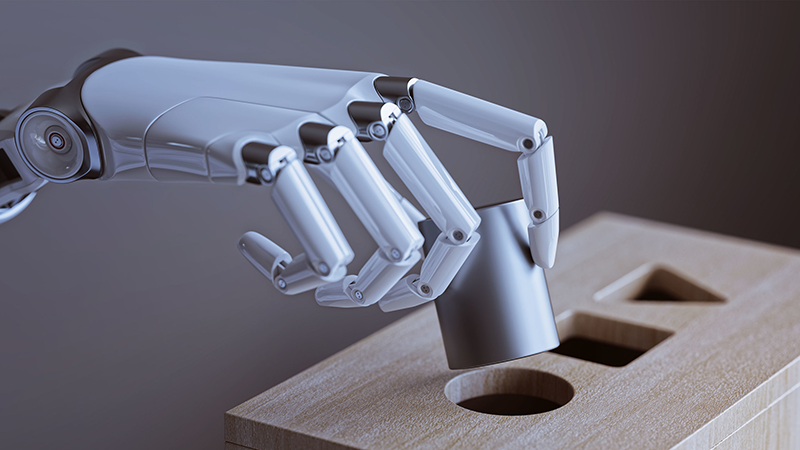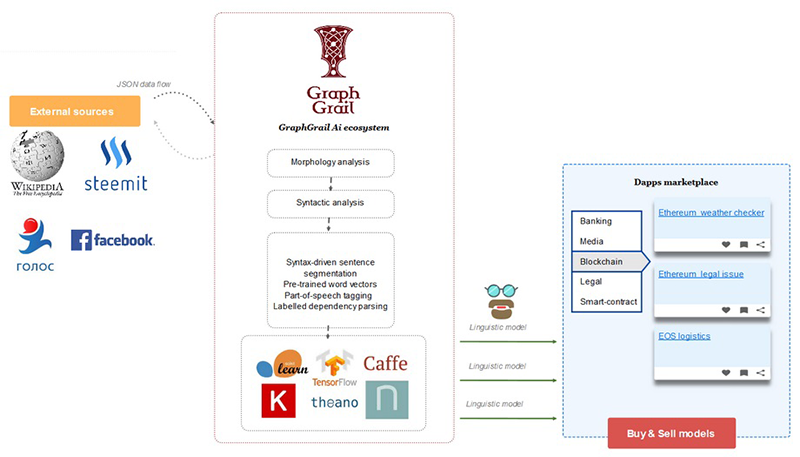Latest news about Bitcoin and all cryptocurrencies. Your daily crypto news habit.

Artificial intelligence has fascinated the human imagination since the times this term started appearing in sci-fi books. Computer science is developing rapidly, and nowadays intelligent computers are no longer fiction — they are the reality.
Blockchain technology was first described in 2008 by an anonymous inventor of Bitcoin, Satoshi Nakamoto. Nobody knows anything about this person or group of people, and Mr. Nakamoto left the project in 2010. Yet, his (or their) brainchild is still alive and kicking, and is implemented in innovative projects all over the world.
Nowadays, we are facing the era of development of two progressive technologies — blockchain and artificial intelligence. Blockchain has already changed our perception of the capabilities of the internet and allowed the speed of internet transactions to be drastically increased, to make them more transparent. AI has already opened new horizons for different spheres of business, allowing optimiziation of the routine work and switching the attention of human workers to tasks of more importance and complexity.
In this article, we will tell you about the possibilities and challenges of the integration of blockchain and AI technologies. We are also going to show how this idea was implemented in a real project.
The perspectives of the integration
The concept of artificial intelligence is widely used for denoting the computers that can work in projects where the work of human intelligence is necessary. Such technologies as artificial neural networks, machine learning, and deep learning make this possible.
Blockchain is a new system of storing digital information in an encrypted and distributed way. It allows creating a highly secured database where all the information can be stored in a structured way and will become publicly available.
Let’s see how we can benefit from the use of blockchain and AI together.
Blockchain explains the actions of AI better than people
Humans can create the artificial neural networks and teach the computer algorithms to expand their capabilities based on experience with the help of machine-learning algorithms. Yet, even the developers of artificial intelligence are not able to predict its actions or to explain its way of thinking. The AI-systems that operate the complex decision trees are sort of black boxes for human intelligence. We are unable to understand the way artificial intelligence thinks.
This is because of the capability of the computer to analyze such amounts of data that we cannot even imagine. The machine’s memory contains more information than the brains of the most intelligent people in the world, and it has to define which of the information is more or less important. We can create the algorithm that will teach the computer to do this, yet we cannot predict how this algorithm will develop.
If all the decisions of the AI system are recorded in the blockchain, we will receive the extensive database and will be able to check the decisions taken by AI and to explain their logic. Additionally, it will ensure the security of the data since the information stored in blockchain cannot be falsified.
AI can increase the efficiency of blockchain
Blockchain transactions are validated by the miners who spend their computing power on trying different combinations of characters in order to guess the right one and to receive a reward. Yet, the money is only given to the one who is first to find the combination, and the power spent by the other miners is wasted. In the future, the AI trained by machine learning algorithms will be able to guess the code in an intelligent way, instead of wasting time and power trying each variant. This will speed up and cheapen the process of validation.
Another challenge of introducing blockchain in our everyday lives is the size of the data. Every piece of information is securely recorded in blockchain and is kept on every computer in the network. The number of blocks increases and the chain becomes heavier with time. The data-storing methods of blockchain can also be optimized with the help of machine-learning algorithms.
The benefits of integration
The work of decentralized artificial intelligence will be based on a parallel computing system consisting of numerous independent nodes located all over the world.
The distributed nature of the system will make it possible to use all its computation power to the fullest extent, and to analyze huge data sets quickly. The dataset will be split into smaller units analyzed by separate nodes, and then the results will be united into an integral database.
This worldwide database will not be controlled by a dominant company, and the information will be available to every member of the network. It will also be possible to use this immense data for training the advanced AI-algorithms.
At the same time, the decisions of the artificial intelligence will also be logged in the database, which will make their work more transparent and comprehensible for humans.
The challenges of integration
Despite the amount of time and money spent on exploring blockchain and AI technologies, there are still some challenges to overcome in order to become ready for integration.
Security challenge
In order to function and perfect themselves, the AI-based application needs to process huge amounts of data. Blockchain is a securely encrypted, worldwide distributed database that can provide artificial intelligence with unlimited and reliable information.
Since blockchain technology is based on cryptography algorithms, it is hard for criminals to hack the system and steal sensitive information. Yet, in order to make changes to the secured data, it is necessary to first decrypt the files, leaving them vulnerable to attack from hackers.
This challenge can be solved with the help of homomorphic encryption: a method of encryption that allows handling mathematical operations to the encrypted data and receives the encrypted result. This technique was first described in 2009 by Craig Gentry — an IBM trainee and a PhD student at Stanford University.
Despite its progressiveness and security, the encryption system of Gentry is currently impossible to realize since it requires using a lot of computing power. For example, a simple operation like Google search would take about a trillion times more time. Yet, the system is being gradually optimized by scientists and, in future, the power of AI will make its implementation in real life possible.
Practical implementation of distributed artificial intelligence: GraphGrail
The modern market does not have a service that would give the possibility of the full lifecycle development of linguistic models without programming. Usually, other software companies are hired for this purpose, and the process of development is very long (about 5–12 months) and expensive.
The creators of GraphGrail AI tried to solve this problem by developing a blockchain-based marketplace for building the decentralized applications for natural language processing. The mission of the project is to create a worldwide open artificial intelligence that would be controlled and developed by programmers all over the world.
Data analysis becomes easier
GraphGrail AI designer is a progressive analytical platform allowing businesses and government institutions to deal with the analysis and classification of large volumes of text data.
The following branches of business are tightly dealing with big data analysis:
- financial sector (analyzing the market of currency/estate/securities, creating the forecasts, structuring the data, creating outputs in graphs and reports)
- telecommunication and media (analyzing of the latest news and trends, content generating)
- consulting, customer service, tourism, medicine etc. (training the chatbots for improving the user experience)
GraphGrain provides the platform for design of NLP-oriented applications in a quick and convenient way without engaging a team of developers. It is also possible to test and improve the application in order to increase its precision and to sell it right there in a marketplace. The platform will simplify the following aspects of data analysis:
- filtering out the irrelevant information (spam and fraudulent content, the articles of low quality)
- knowledge extraction (analyzing the internal information of the companies, the services and products of competitors, categorization of news, parsing the figures and statistics, etc.)
The main advantage of GraphGrail is its ability to perform the full lifecycle development, starting with collecting the data and training the neural network, and ending with output of the end result in the web-interface or the reports of the necessary format.
The structure of the project
The architecture of GraphGrail AI consists of two modules, each of them performing different functions:
Pragmatic module is responsible for understanding the content of the text. It includes:
- Morphological analysis of each separate word
- Syntactic analysis of the structure and content of each separate sentence
- High-level pragmatic analysis of the entire text.
Neural network module is responsible for training the neural network basing on the data received while data processing via the pragmatic one.
The benefits of two-module architecture
- It is possible to create the NLP-based applications even for a person without a technical background
- It constantly improves the quality of training the neural network
- It makes it possible to define the complex linguistic features of a particular area
Practical application of the project
GraphGrail AI designer allows their customers to create AI-based solutions for a particular business. The possibilities of the platform can be used in the following ways:
Prediction analytics
The custom solution developed with the help of the platform is able to collect and monitor cryptocurrency-related posts. The results are output on an advising dashboard with the possibility of helping in trading and forecasts regarding the market of digital currency.
Filtering the relevant messages
This function will be appreciated by active users of messengers. It is impossible to read all the messages in the active chats, and the NLP-based filter will parse the messages with the relevant content: business offers, news, the experience of the participants.
GraphGrail AI designer can also be applied by the companies from the media industry. To find out more about the NLP technology in journalism, please refer to our recent article.
Conclusion
Having read this article, you are now aware of the possible benefits and challenges of blockchain and artificial intelligence integration. Uniting these progressive technologies will revolutionize the way the business is conducted, and GraphGrail AI-designer is proving this. Sloboda Studio also has the experience of decentralized AI development. In our next article, we will gladly share it with you. Stay tuned, and let us know should you have any questions.
Originally published at sloboda-studio.com on June 26, 2018.
How Blockchain and AI Integration is Changing Business was originally published in Hacker Noon on Medium, where people are continuing the conversation by highlighting and responding to this story.
Disclaimer
The views and opinions expressed in this article are solely those of the authors and do not reflect the views of Bitcoin Insider. Every investment and trading move involves risk - this is especially true for cryptocurrencies given their volatility. We strongly advise our readers to conduct their own research when making a decision.

